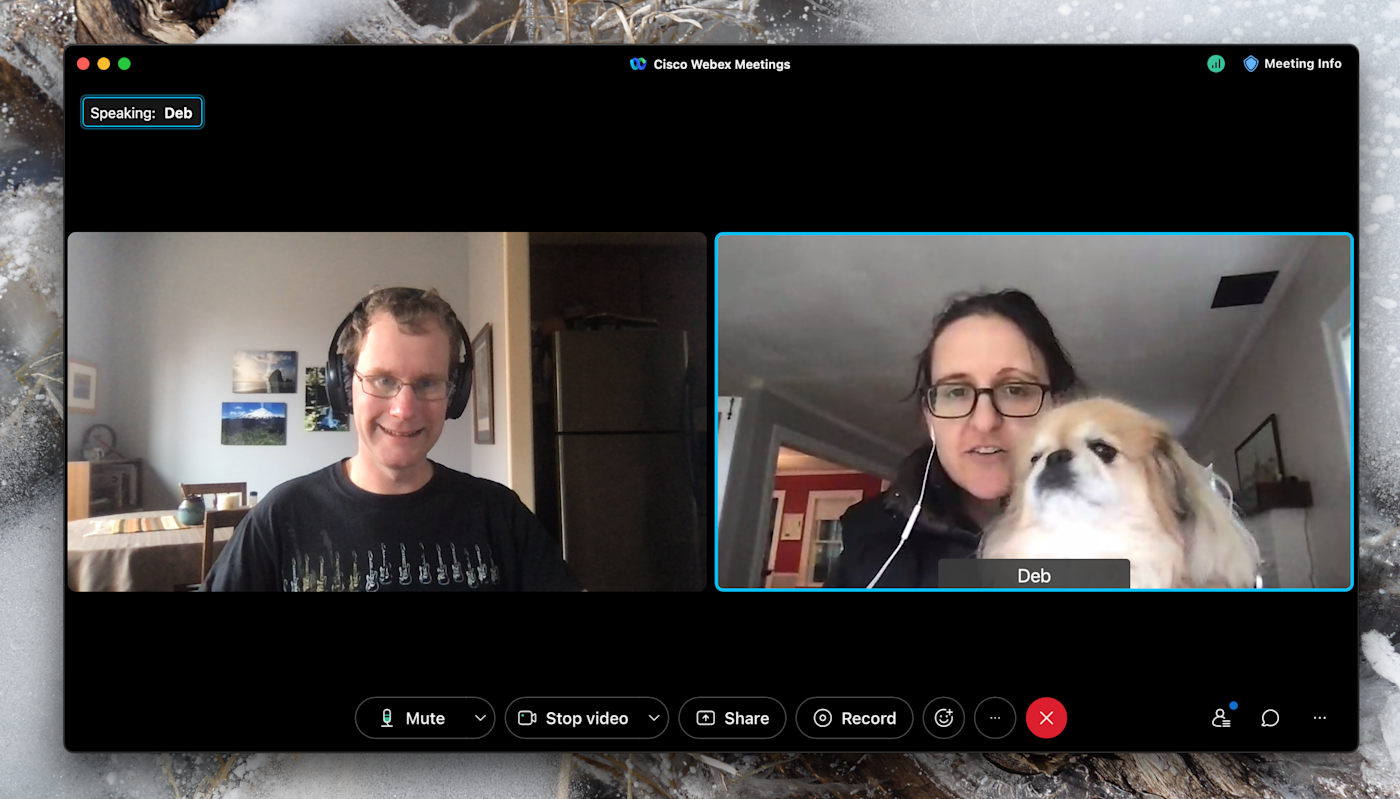Video conferencing software isn’t niche anymore—it’s the main place meetings happen. It’s true in remote companies, it’s true in hybrid companies, and it’s increasingly true in companies that mostly work in physical offices.
Don’t let meetings dominate your work
So low-quality video calls aren’t a niche problem—they’re bad for productivity all around. Every dropped call is a major annoyance, and it’s also not acceptable to waste time waiting for someone to set up software that’s not intuitive.
That’s why we did our homework for this article. We considered over 30 video conferencing apps and spent a lot of time testing to learn how they stacked up. Here are the five best.
The 5 best video conferencing platforms
What makes a great video conferencing app?
The most important thing for video conferencing is video quality. That goes beyond how the picture looks—the best quality in the world doesn’t matter if people cut out or calls drop constantly. We tested each platform to see how well they performed when the quality of the internet connection changed.
But that’s not the only thing we were thinking of. There are many consumer-facing video chat apps—FaceTime, for example—that wouldn’t work as a video conferencing app. Businesses need more than just a solid video connection to do meetings. In summary, the best video conferencing apps:
-
Offer high-quality video and audio, reliably. This is essential.
-
Make it straightforward to start, schedule, and join meetings. Ideally, meetings can be quickly scheduled and added to your calendar, and there should be obvious links to click when it’s time to join the call.
-
Include collaboration features. Screen sharing and chat are the bare minimum. The best apps go beyond this to offer whiteboarding or even direct collaboration features.
-
Allow for video recording. Not everyone can make every meeting—recordings help bridge that gap. Recording a meeting should be as simple as clicking a button.
-
Make it simple to add people outside your organization. Anyone should be able to click a link and join your meeting without much fuss (though there should also be security features to keep out unwanted participants).
We kept all of these features in mind while considering which apps to test, then focused on these features while testing.
The best video conferencing app for reliable, large video calls
Zoom (macOS, Windows, iOS, Android, Web)

You already know about Zoom. People who literally live under rocks know about Zoom. It’s the most popular video conferencing app out there, and for good reason: it just works.
You can share a link to a Zoom meeting and feel confident that everyone will be able to join it. There are apps for every major platform, and at this point, you can assume everyone already installed them. Joining a meeting is as simple as clicking the link. It’s hard to overstate how valuable that is: nothing drags a meeting down quite like someone not being able to join.
Zoom is also extremely reliable. It will typically keep your video going even through a weak internet connection, just at a reduced quality level. You can record any call as a full-length video, and participants can also use text chat to talk with each other, either as a group or as individual private messages. And you can share your screen, an individual app, or just one section of your screen. You can even share audio from your computer, if you want.
Zoom lets you schedule calls in advance, chat anytime with any of your contacts, or connect to room conferencing hardware. All in all, it’s a nearly perfect team video app.
You can do even more with Zoom by connecting it to Zapier, taking the busywork out of meeting prep and follow-up. For example, you can automatically add Zoom calls to your calendar, schedule video conferences when someone books an appointment, or get notifications for upcoming meetings.
Zoom Price: Free for up to 100 participants for 40-minute meetings; from $14.99/month/host with the Pro plan, which includes user management, unlimited meeting length, and reporting.
The best video conferencing app for Google Workspace users
Google Meet (iOS, Android, Web)

Google Meet’s best feature, perhaps, is its deep integration with Google’s other apps. Whenever you create a meeting in Google Calendar, you’ll get a Meet link that you and your meeting attendees can click to instantly join a call. And when you’re in the middle of a call, you can find files from Google Drive and share them in chat, without leaving your call. You can even start a call directly from your Gmail inbox.
Google Meet includes live captioning, which is a huge plus for accessibility. The captions work fairly well in English, though it can’t detect when other languages are spoken on a call. And then there’s the integration with Chrome, including a tab-sharing feature that’s great for media sharing, with very little lag when used to stream a short video as a group (it doesn’t work in other browsers, though).
Meet runs in a browser, not an app. This can be seen as a plus, because you don’t need to install anything. In our experience, though, browser-based apps tend to struggle on large group calls. Meet is no exception—large calls result in loud laptop fans and reduced quality. In our experience, Meet also doesn’t degrade calls as gracefully as Zoom when your internet connection is slow. But there is a workaround: you can opt to have up to 100,000 participants join via view-only mode. This mode doesn’t display participants’ video, so they’ll only see and hear whoever is leading the call. Though it’s not the same as a true video conference, since it limits their ability to chime in, it’s a decent option if you just need one or two people to present to a large group.
Hybrid companies, or companies with multiple locations, can use the Meet conference room devices for full-room video chats and the Jamboard touchscreen device for team collaboration. Together with Meet’s deep integrations with the rest of Google Workspace, Meet just may turn into the best way to talk with your team. And, if your company is already paying for Google Workspace, it’s essentially free.
With Zapier, you can connect Google Meet to the other apps you use most. For example, you can automatically schedule calls with leads, no matter where they reach you.
Google Meet Price: Free for up to 100 participants and up to 60 minutes; from $6/month/user as part of Google Workspace Business Starter.
The best combination team chat and video conferencing app
Microsoft Teams (web, macOS, Windows, iOS, Android, Linux)

Most team chat apps struggle with video, or treat it as an afterthought. Not Microsoft Teams, which offers some of the most robust video conferencing features on the market.
The whiteboard, for example, is the best we tested while researching this article. You can draw freehand, and the program smooths things out—a crappy circle becomes a perfect one, for example. This makes it easy to take notes and diagram things on the fly. And there are plenty of other collaboration features here. The chat from the meeting, for example, is saved in your team chat app for future reference. There’s a built-in feature for meeting notes, which are also shared with the team after the meeting. You can even automatically transcribe meetings and share that.
None of this would matter if the video quality wasn’t great. It is. Teams works well even with large calls, and there are all kinds of features for helping the meeting go smoothly. Some, like the together mode seen in the above screenshot, are gimmicks, sure, but even gimmicks can help with team cohesion.
It’s not a perfect app. Microsoft has a tendency to keep adding features to their applications, cluttering up the interface. That’s very much the case with Teams. And while it’s easy to invite people outside your organization to a Teams meeting, it’s not as seamless as Zoom. Expect hiccups if someone doesn’t already have Teams installed.
As for the cost? You’re probably already be paying for it because Teams comes bundled with basically every version of Microsoft Office. If you want a team chat app that also offers high-quality videoconferencing, Teams is worth checking out.
And you can do even more with Teams by connecting it to Zapier. For example, you can get notifications in Teams whenever your team has a new lead, a new event registration, or a new deal.
The best video conferencing app for a lightweight option
Whereby (Web)

There are many browser-based video conferencing services out there. Most of them aim to make it easy for anyone to quickly create a meeting link, share it, and start a meeting. Simplicity is the point.
Whereby is the best app in this sub-category. If you want to quickly start a meeting, Whereby is perfect. Starting and sharing a link could not be much easier, and in our tests, no one had trouble joining. There’s support for up to 100 people, a prominent record button, a chat function, and screen sharing.
There’s also an integration feature, which works differently from anything else we tested. Most video conferencing apps rely on some version of screen sharing for collaboration. Whereby actually embeds productivity apps right on the page. For example: open the Google Docs integration, and a document will be loaded right there in meeting. Everyone can edit the document right there, after logging into Google Docs, because this isn’t a video of the document—it’s the actual document, in the window, alongside your video chat. You could argue that Whereby integrates with Google Docs better than Google Meet does. The YouTube integration also works better in Whereby than in Meet, which tells us Google could learn a few things from this app.
If you’re looking for a browser-based video conferencing app—one that doesn’t require accounts for participants—check out Whereby first.
Whereby pricing: Free plan includes up to 100 participants and group meetings up to 45 minutes; from $6.99/month/user for the Pro plan, which offers unlimited group meetings, recording, and custom branding and domains.
The best video conferencing app for video quality
Webex Meetings (iOS, Android, Mac, Windows)

Cisco is a leading manufacturer of video conferencing hardware. Webex Meetings is their software offering. As you might expect, the focus is on video quality, and Webex delivers. We immediately noted that everyone looks and sounds better on this service (even Winston, pictured above, looking perfect in the right panel).
If you tried Webex a couple years ago, you might want to try it again—it’s been completely overhauled in the past year.
Users need to download an app in order to join a meeting, which is a downside, but the installation is relatively straightforward. The collaborative features are particularly noteworthy. You can share a document with the meeting, as opposed to sharing the screen. Everyone in the meeting can mark up the file. There’s also a fantastic virtual whiteboard, comparable to what’s offered in Microsoft Teams, with drawing, text, shapes, and other features. As with documents, everyone on the call can collaborate at the same time. It’s a great way to think out loud about a project as a group.
By connecting Webex to your other apps with Zapier, it’s easy to keep your meetings running smoothly. You can automatically add scheduled Webex meetings to your calendar, for example, or get a reminder in your favorite chat app when a meeting is about to start.
Webex Price: There’s a free plan for meetings with up to 100 people, but it lacks some important features like screen sharing and recordings. From $25/user/month for the Business plan for advanced team features.
Originally published in January 2017 by Matthew Guay, this article has also had contributions from Hannah Herman.
[adsanity_group align=’alignnone’ num_ads=1 num_columns=1 group_ids=’15192′]
Need Any Technology Assistance? Call Pursho @ 0731-6725516




